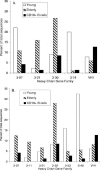Immune response to pneumococcal polysaccharides 4 and 14 in elderly and young adults: analysis of the variable heavy chain repertoire
- PMID: 16239548
- PMCID: PMC1273876
- DOI: 10.1128/IAI.73.11.7465-7476.2005
Immune response to pneumococcal polysaccharides 4 and 14 in elderly and young adults: analysis of the variable heavy chain repertoire
Abstract
Streptococcus pneumoniae is a leading cause of morbidity and mortality in both developed and developing countries. The current pneumococcal polysaccharide (PPS) vaccine is highly effective in young adults; however, vaccine efficacy is dramatically decreased in the elderly population. We hypothesized that the decreased vaccine efficacy in the elderly results from altered variable gene family usage. We have characterized the immunoglobulin G gene usage of the antibody response to PPS4 and PPS14 in 20 young and 20 elderly adults. The variable heavy (V(H)) gene repertoire of human peripheral B cells was amplified by using PCR. A total of 364 heavy chain sequences with specificity for PPS4 and 305 heavy chain sequences for PPS14 were analyzed from young adults. In addition, a total of 325 sequences for PPS4 and 291 sequences for PPS14 were obtained from elderly adults. Complete sequence identity, somatic mutation frequencies, and V(H) gene usage was determined in response to PPS4 and PPS14. In all volunteers, the immune response to both polysaccharides consisted predominantly of heavy chains belonging to the V(H)3 gene family. There were significant differences in the variable gene repertoire between young and elderly adults. Somatic mutation occurred more frequently in sequences derived from young compared to elderly derived sequences. With aging, a loss of oligoclonality was noted in response to PPS4 and PPS14 compared to young adults. The observed differences in V(H) repertoire, somatic mutation, and loss of oligoclonality may contribute to decreased vaccine efficacy in the elderly.
Figures

Similar articles
-
Immune response to pneumococcal polysaccharides 4 and 14 in elderly and young adults: analysis of the variable light chain repertoire.Infect Immun. 2005 Nov;73(11):7477-84. doi: 10.1128/IAI.73.11.7477-7484.2005. Infect Immun. 2005. PMID: 16239549 Free PMC article. Clinical Trial.
-
Differential V gene expression detected in the immune response to Streptococcus pneumoniae capsular polysaccharide between elderly and young adults.Hybrid Hybridomics. 2002 Feb;21(1):19-24. doi: 10.1089/15368590252917601. Hybrid Hybridomics. 2002. PMID: 11991813
-
Recurrent variable region gene usage and somatic mutation in the human antibody response to the capsular polysaccharide of Streptococcus pneumoniae type 23F.Infect Immun. 2002 Aug;70(8):4083-91. doi: 10.1128/IAI.70.8.4083-4091.2002. Infect Immun. 2002. PMID: 12117915 Free PMC article.
-
Somatic hypermutation and diverse immunoglobulin gene usage in the human antibody response to the capsular polysaccharide of Streptococcus pneumoniae Type 6B.Infect Immun. 2004 Jun;72(6):3505-14. doi: 10.1128/IAI.72.6.3505-3514.2004. Infect Immun. 2004. PMID: 15155658 Free PMC article.
-
Somatic mutation of human immunoglobulin V genes: bias, rate, and regulation.Ann N Y Acad Sci. 1995 Sep 29;764:158-69. doi: 10.1111/j.1749-6632.1995.tb55820.x. Ann N Y Acad Sci. 1995. PMID: 7486516 Review. No abstract available.
Cited by
-
Shared B cell memory to coronaviruses and other pathogens varies in human age groups and tissues.Science. 2021 May 14;372(6543):738-741. doi: 10.1126/science.abf6648. Epub 2021 Apr 12. Science. 2021. PMID: 33846272 Free PMC article.
-
Terminal Deoxynucleotidyl Transferase Is Not Required for Antibody Response to Polysaccharide Vaccines against Streptococcus pneumoniae and Salmonella enterica Serovar Typhi.Infect Immun. 2018 Aug 22;86(9):e00211-18. doi: 10.1128/IAI.00211-18. Print 2018 Sep. Infect Immun. 2018. PMID: 29967094 Free PMC article.
-
Vaccination-induced changes in human B-cell repertoire and pneumococcal IgM and IgA antibody at different ages.Aging Cell. 2011 Dec;10(6):922-30. doi: 10.1111/j.1474-9726.2011.00732.x. Epub 2011 Aug 10. Aging Cell. 2011. PMID: 21726404 Free PMC article.
-
The immune response to pneumococcal polysaccharides 14 and 23F among elderly individuals consists predominantly of switched memory B cells.J Infect Dis. 2013 Jul;208(1):101-8. doi: 10.1093/infdis/jit139. Epub 2013 Apr 1. J Infect Dis. 2013. PMID: 23547142 Free PMC article.
-
Progenitor B-1 B-cell acute lymphoblastic leukemia is associated with collaborative mutations in 3 critical pathways.Blood Adv. 2017 Sep 8;1(20):1749-1759. doi: 10.1182/bloodadvances.2017009837. eCollection 2017 Sep 12. Blood Adv. 2017. PMID: 29296821 Free PMC article.
References
-
- Austrian, R. 1981. Some observations on the pneumococcus and on the current status of pneumococcal disease and its prevention. Rev. Infect. Dis. 3:S1-S17. - PubMed
-
- Banerjee, M., R. Mehr, A. Belelovsky, J. Spencer, and D. K. Dunn-Walters. 2002. Age- and tissue-specific differences in human germinal center B-cell selection revealed by analysis of IgVH gene hypermutation and lineage trees. Eur. J. Immunol. 32:1947-1957. - PubMed
-
- Baxendale, H. E., Z. Davis, H. N. White, M. B. Spellerberg, F. K. Stevenson, and D. Goldblatt. 2000. Immunogenetic analysis of the immune response to pneumococcal polysaccharide. Eur. J. Immunol. 30:1214-1223. - PubMed
-
- Breitbart, E., X. Wang, L. S. Leka, G. E. Dallal, S. N. Meydani, and B. D. Stollar. 2002. Altered memory B-cell homeostasis in human aging. J. Gerontol. A Biol. Sci. Med. Sci. 57:B304-B311. - PubMed
-
- Brezinschek, H. P., R. I. Brezinschek, and P. E. Lipsky. 1995. Analysis of the heavy chain repertoire of human peripheral B cells using single-cell polymerase chain reaction. J. Immunol. 155:190-202. - PubMed
Publication types
MeSH terms
Substances
Grants and funding
LinkOut - more resources
Full Text Sources
Other Literature Sources
Medical

